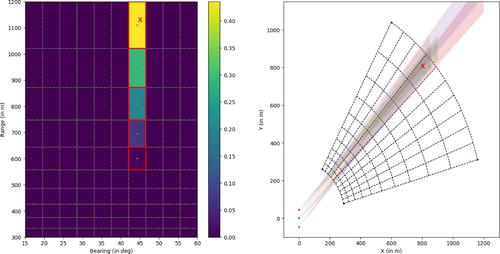当前位置:
X-MOL 学术
›
IET Radar Sonar Navig.
›
论文详情
Our official English website, www.x-mol.net, welcomes your feedback! (Note: you will need to create a separate account there.)
Enhancing model-based acoustic localisation using quantum annealing
IET Radar Sonar and Navigation ( IF 1.7 ) Pub Date : 2024-03-01 , DOI: 10.1049/rsn2.12534 Robert Wezeman 1 , Tariq Bontekoe 1, 2 , Sander von Benda‐Beckmann 1 , Frank Phillipson 1, 3
IET Radar Sonar and Navigation ( IF 1.7 ) Pub Date : 2024-03-01 , DOI: 10.1049/rsn2.12534 Robert Wezeman 1 , Tariq Bontekoe 1, 2 , Sander von Benda‐Beckmann 1 , Frank Phillipson 1, 3
Affiliation

|
Model-based acoustic localisation estimates the locations of underwater objects by comparing sensor measurements with model predictions. To obtain high quality predictions, propagation models need to be run for a large set of environmental parameters. However, real-time Model-based acoustic localisation estimations using onboard computational resources are often limited. To address this, the authors propose a Quantum annealing (QA) algorithm for enhancing underwater acoustic localisation. A restricted Boltzmann machine (RBM) is trained to predict the probability distribution of underwater targets. Advantage of this approach is that part of the computation is moved to offline-training. Moreover, the probability distribution can potentially be sampled efficiently using a quantum annealer possibly enabling real-time accurate target estimations being made onboard.The RBM is applied to a simplified multi-sensor horizontal localisation problem where a constant and linear acoustic propagation is assumed. Using simulated annealing the authors show that the RBM is able to learn probability distributions that resemble target locations. Preliminary results show that training and sampling the RBM can be done using QA hardware by D-Wave Systems.However, there remains room for improvement especially in ranging predictions. Further research into possible benefits of QA RBMs is needed to provide theoretical and practical results of a speed-up.
中文翻译:

使用量子退火增强基于模型的声学定位
基于模型的声学定位通过将传感器测量值与模型预测进行比较来估计水下物体的位置。为了获得高质量的预测,需要针对大量环境参数运行传播模型。然而,使用机载计算资源进行的基于模型的实时声学定位估计通常是有限的。为了解决这个问题,作者提出了一种量子退火 (QA) 算法来增强水声定位。训练受限玻尔兹曼机(RBM)来预测水下目标的概率分布。这种方法的优点是部分计算转移到离线训练。此外,使用量子退火器可以有效地对概率分布进行采样,从而可以在机上进行实时准确的目标估计。RBM 应用于假设恒定且线性的声学传播的简化的多传感器水平定位问题。作者使用模拟退火表明 RBM 能够学习类似于目标位置的概率分布。初步结果表明,可以使用 D-Wave Systems 的 QA 硬件来完成 RBM 的训练和采样。然而,尤其是在测距预测方面,仍然存在改进的空间。需要进一步研究 QA RBM 可能带来的好处,以提供加速的理论和实践结果。
更新日期:2024-03-03
中文翻译:

使用量子退火增强基于模型的声学定位
基于模型的声学定位通过将传感器测量值与模型预测进行比较来估计水下物体的位置。为了获得高质量的预测,需要针对大量环境参数运行传播模型。然而,使用机载计算资源进行的基于模型的实时声学定位估计通常是有限的。为了解决这个问题,作者提出了一种量子退火 (QA) 算法来增强水声定位。训练受限玻尔兹曼机(RBM)来预测水下目标的概率分布。这种方法的优点是部分计算转移到离线训练。此外,使用量子退火器可以有效地对概率分布进行采样,从而可以在机上进行实时准确的目标估计。RBM 应用于假设恒定且线性的声学传播的简化的多传感器水平定位问题。作者使用模拟退火表明 RBM 能够学习类似于目标位置的概率分布。初步结果表明,可以使用 D-Wave Systems 的 QA 硬件来完成 RBM 的训练和采样。然而,尤其是在测距预测方面,仍然存在改进的空间。需要进一步研究 QA RBM 可能带来的好处,以提供加速的理论和实践结果。



























 京公网安备 11010802027423号
京公网安备 11010802027423号